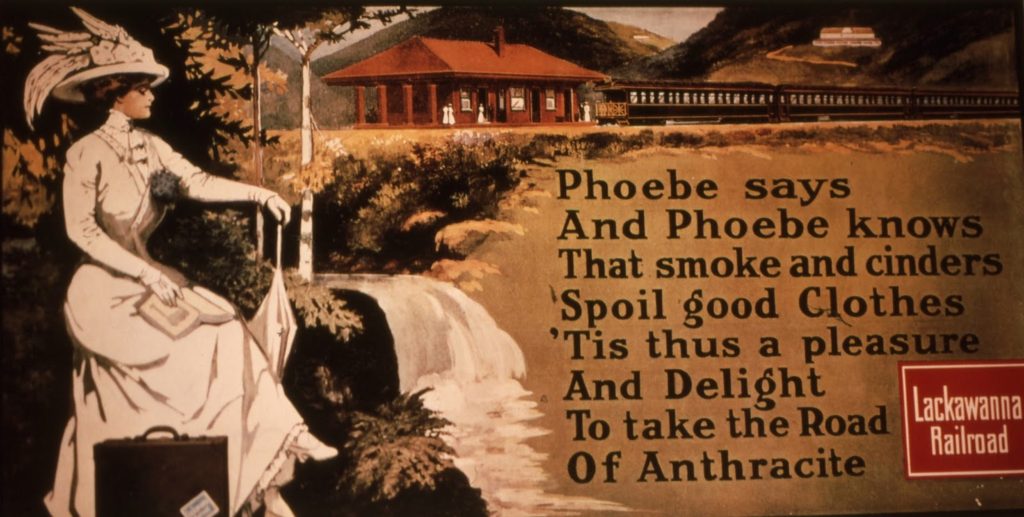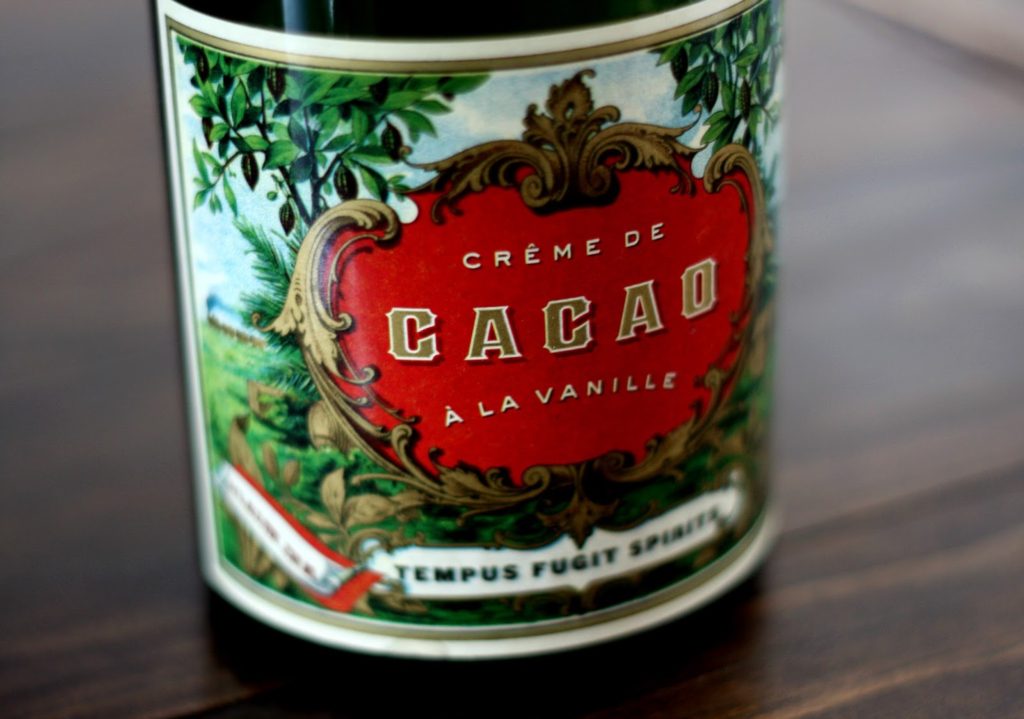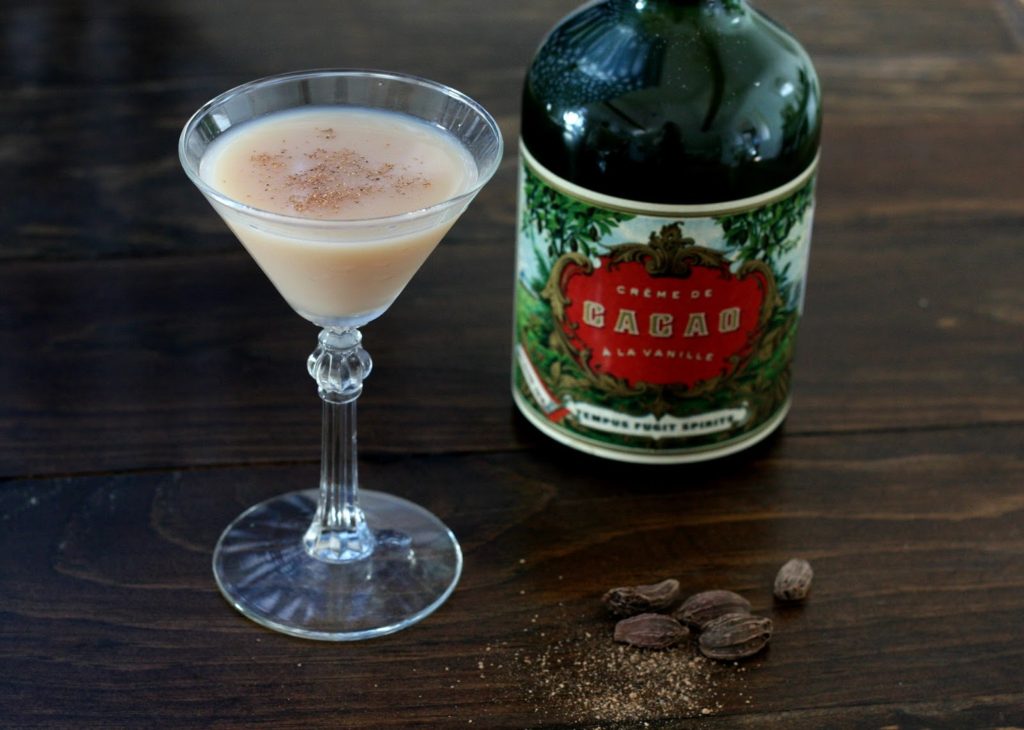I don’t make a lot of desserty cocktails, so a bottle of crème de cacao was never that high on my list of things to buy. Don’t get me wrong – I love chocolate. Love it. And I wouldn’t say no to a chocolate martini if you handed me one. But it’s not really something I’d like to make on a regular basis. So of all the spirits I’d like to buy, I didn’t think crème de cacao had much of a place in my bar.There was a particular cocktail that changed my mind. My husband and I were checking out the tiki bar at Tiger Mama, a funky southeast-Asian inspired restaurant in the Fenway area that opened up a few months ago. While I opted for something appropriately Tiki-themed and served in a coconut, the hubby went straight for a drink called the Flushing – Main Street. The ingredients were so bizarre it seemed they might work: Akashi White Oak Japanese whiskey, dry vermouth, Green Chartreuse, and crème de cacao. We loved it. I’ll post the recipe soon so you can try it yourself and see if you agree.
I asked the bartender about the unusual inclusion of crème de cacao in the recipe, and he told me they use the one from Tempus Fugit. This was the first time I’d heard of Tempus Fugit, but it wasn’t the last – their Gran Classico and Kina L’Aero d’Or seem to be making their way into drinks at every bar in Boston. All of their labels are gorgeously vintage-styled, and their spirits are excellent. The bartender at Tiger Mama assured me that no other crème de cacao would do. “It’s the best,” he said. I went on the hunt for it and found it at Liquor Land on Mass Ave. When I asked one of the employees if they had it, he pointed it out to me and added, “It’s the best.” Okay, then.
If you’re like me, when you hear “crème de cacao” you think of a sugary, cheap, Dekuyper-esque liqueur. And that’s probably not far off for a lot of brands on the market. John Troia, co-founder of Tempus Fugit Spirits, says the decline of crème de cacao from an elegant liqueur to a sickly sweet bottom-shelf mixer had to do with the rise of the cocktail. When the liqueur was no longer being consumed by itself, it was easier to skimp on quality and make more sugary products with artificial flavoring. But like many classic ingredients, crème de cacao is making a comeback.
Crème de cacao was invented by monks in France in the 16th century. Chocolate was still a pretty new import to Europe at the time, but it never seems to take long for people to figure out how to make booze out of something. It’s is not a cream liqueur; it gets its name from its thick, creamy texture. It’s made by distilling cacao, otherwise known as cocoa beans. If you’re not familiar with where your Hershey’s chocolate bar comes from, let me briefly enlighten you: chocolate comes from the seeds of the cacao tree, Theobroma cacao, which is native to Central and South America. Its fruits are oval-shaped pods that turn yellow or red when ripe. Inside, there’s a sweet white flesh (that actually tastes pretty good on its own, though nothing like chocolate) surrounding the real treasure: the cacao beans. These are fermented, dried, roasted, and cracked open to remove their shells. What’s left are what we call cocoa nibs, which are ground up into a paste and mixed with sugar and milk to make chocolate.
If you’re making booze instead, you don’t have to go through quite that much trouble. Though I’m having a little difficulty finding out the details of the process, it appears that real crème de cacao is made by distilling the raw cocoa beans. The distillate is then macerated with more crushed cacao and vanilla beans. I’m sure sugar is added as well. You may notice that there are “white” and “brown” varieties out there. In the cheaper brands, the brown usually comes from artificial coloring. I guess the goal is to make it look more like the real thing: the brown color of Tempus Fugit’s crème de cacao is natural.
 |
| The inside of a cacao pod, with the white flesh surrounding the beans. |
Tempus Fugit’s crème de cacao smells intensely chocolatey, like cocoa powder or a chocolate bar. When you sip it, the first thing you notice is the texture. You understand the “crème” in the name immediately – this stuff is thick and velvety in a completely unexpected way. The flavor is beautiful and rich. Obviously the main taste is chocolate, but there are also strong notes of vanilla and caramel.
I don’t normally endorse a single brand, but as far as I know, Tempus Fugit makes the only real quality crème de cacao out there at the moment. You could reach for something cheaper if you want to try it out before you take the plunge, but you’d already be more than halfway to a bottle of really great stuff. If you’re not ready to shell out $30 on chocolate liqueur, you could do what a lot of craft cocktail bars are doing and make your own from vodka, cacao nibs, sugar, and vanilla.
Tempus Fugit Crème de Cacao
Price: $30
Alcohol Content: 24%
Popular Cocktails: Brandy Alexander, Grasshopper, Chocolate Martini, 20th Century
History: The Brandy Alexander is a version of the Alexander, which was originally made with gin, crème de cacao, and cream. It was (probably) invented by Troy Alexander at Rector’s in New York in honor of (somewhat bizarrely) a cartoon woman named Phoebe Snow who was used to advertise clean-burning coal for railroads. Phoebe wore all white, emphasizing just how clean the coal was. For the dinner in her honor, Alexander wanted to make a white cocktail to match. Somewhat incongruously, he named it after himself. This gin Alexander appears in Hugo Ensslin’s 1915 Recipes for Mixed Drinks.
 |
| An advertisement featuring Phoebe Snow in her white dress. |
Brandy Alexander
1 oz. brandy or Cognac
1 oz. crème de cacao
1 oz. cream, half and half, or milk
Combine all ingredients in a shaker with ice and shake until chilled and frothy. Strain into a cocktail glass and garnish with grated nutmeg.








